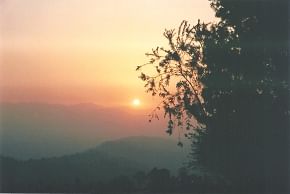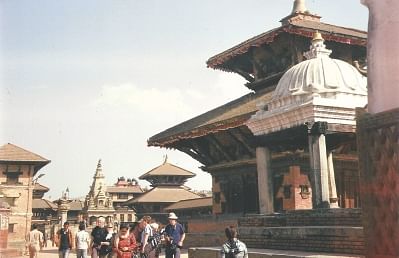| Home - Back Issues - The Team - Contact Us |
 |
| Volume 11 |Issue 14| April 06, 2012 | |
|
|
Travel Sunset at Nagarkot Visiting Nepal- Spring 2012 Azizul Jalil
It is only an hour's flight from Dhaka to Kathmandu, the capital city of the fellow SAARC country, Nepal. Yet for one reason or the other, it has not been possible for us to visit this popular tourist spot. In the spring of 2012, we did manage to go. Despite the sincere advice of the well wishers to avoid taking the daily Biman flight on grounds of its irregularity and bad service, we flew in a Boeing 737 of the Bangladesh Biman. The ground service was good, and to everyone's surprise, the large and clean aircraft took off majestically, exactly on scheduled time. We noticed the warmth and enthusiasm of the Nepalese immigration staff, particularly when they found that it was our first visit. It was good to learn that citizens of SAARC countries can get on arrival visas. After we came out, we were literally mobbed by the taxi drivers who pulled us in different directions to convince us to hire their cabs. The police staff was nowhere near to enforce any discipline. The bumpy and noisy taxi ride on the very narrow and dusty road did not speak well about a city which significantly depends on tourism. Why the main road from the airport to the city cannot be reasonably maintained is beyond my imagination! Perhaps the long internal conflicts have taken a toll and hampered sustained development of a beautiful country with fine, warm people. The day after our arrival was the auspicious day of Holi, when most shops were closed and the joyous celebrations of happy and excited Nepalese people on the streets made it difficult for tourists to venture into the city or travel outside. We did most of our window and real shopping by the second day. The hotel had a casino and when we went to look at it, we found that it was run by Indians and accepted only Indian currency notes. Indian influence and presence was pervasive everywhere in the country. In fact, until the recent abolition of the monarchy, Nepal was the only Hindu kingdom in the world. Instead of visiting Pokhara, a popular destination for Bangladeshi tourists, we rented a car to go to Nagarkot. Located 32 km east of Kathmandu, it was nestled in the high mountains. A great attraction was the sunset at Nagarkot as well as the panoramic view of the major mountain peaks, valleys and ranges of twenty-three thousand feet and above. The road to Nagorkot was narrow and in a bad state, and the shops and houses on the way, rustic as they were, betrayed a lack of development compared to even the rest of the developing world. Due to time constraints, we had only a fleeting glimpse of the old palaces and other structures in Bhaktapur, a small town. Interestingly, instead of Nepalese handicrafts and shawls, local shops were mostly selling Chinese products. Unlike Kathmandu, which was sunny and warm in the day, Nagarkot was chilly in the late afternoon due to its altitude. Looking out of the dining room of the hilltop Himalayan Club Resort, with its high cone-shaped ceiling with large wooden beams and decorations, one could enjoy a magnificent view of the Himalayan valleys, all green in March, and miles and miles of high mountains at a distance. The hill-sides were terraced for cultivation and planted with trees to prevent soil erosion by rain water. The resultant architecture was interesting and pleasing. We spent a little while in that heavenly abode before anxiously climbing down the stairs to the large parking area at the bottom, which they called a helipad, to witness the much-admired sunset, ready with our cameras to take snapshots of the memorable experience.
Local newspapers had predicted sunset at 6:07 pm and that is exactly when it happened. Indeed, nature did not fail our high expectations. Even though it was a bit foggy, we had a breathtaking view of the orange and crimson-coloured haze of fog as the setting sun in all its glory and brightness gracefully started its descent at 5:30 pm to hide in the mountains until next morning. At that time, the fog cleared a bit and against a blue sky, the luminous sun, resplendent in all its hue and glory, became clearly visible. A countdown started as we stood silent before a grand natural spectacle. As ill luck would have it, I was carried away in my eagerness and enthusiasm to take many quick shots. Just at the moment when the sun drops like a stone and goes out of view, my camera not being a digital one, ran out of film. I was in such a hurry to promptly reload it that I missed the actual grand finale. But what I had captured in the earlier moments both in my mind and in the camera were satisfying. With this wonderful experience of seeing nature's magic and entertainment, we returned to our hotel in Kathmandu at about 8 pm. The next two days were planned for sightseeing in Kathmandu and nearby Patan, visiting the palaces, temples and museums. The best kept was the Narayanhiti Palace. The smaller building at the rear still has bullet marks of the 2001massacre of King Birendra, Queen Aishwarya and seven others. The assailant Prince Dipendra killed himself in the garden behind the building. Most of the building has now been demolished as the Nepalese do not wish to remember the carnage of the royal family members. A modest notice on the site, however, marks the tragic event. The palace was used for ceremonies, for receiving royalty and other dignitaries from abroad and for cabinet meetings, investitures and royal audiences. The walls have many pictures, including two of former President Ziaur Rahman, and attractive paintings. The palace had large well-maintained gardens where flowers were in full bloom. In contrast, the old palace at the Hanumandhoka Durbar Square, declared as a UNESCO heritage site, needed care and attention. It has a unique architectural design and intricate wood work all over. There were innumerable paintings and pictures of the royal family, mainly of King Tribhubana. The narrow staircases at places covered nine floors and were often inadequately lit. For older people or people without good vision, the tour can be a risky enterprise. The trouble is, once you start the palace tour, you have to go through the entire round - there is no way to abort it. Coming out of the palace area, we were having difficulty in finding a taxi back to the hotel, when we met a lovely Nepalese lady on the street who spoke fluent English. She was from New York on one of her regular visits to the city where she grew up and where her mother still lives. She not only walked a distance in the sun to the taxi stand but insisted on negotiating the price of the ride so that we wouldn't be charged exorbitantly. From the shop keepers to the men in the restaurants and others we met elsewhere, the Nepalese people were gentle, courteous and helpful. Traditions and customs remain a part of the life of the Nepalese, including the elite. Incidentally, when we invited a foreign-educated young couple in their late thirties, a young pilot and his wife working in a foreign aid agency to dinner at our hotel one evening, we noticed that their parents were tenderly monitoring their security and welfare by cell phone. On our way back to Dhaka, the pilot did us a great favour by flying the aircraft parallel to the Himalayas for the first 15 minutes or so. This gave us a clear, panoramic view from a height of about twenty-thousand feet of the mountain ranges and high peaks, including the mighty Everest. It appeared to stand with its head held high at a distance from the rest.
Copyright
(R) thedailystar.net 2012 |

